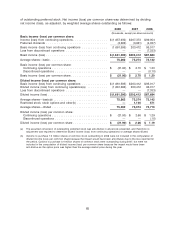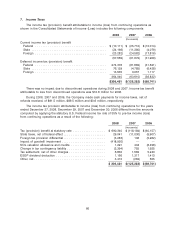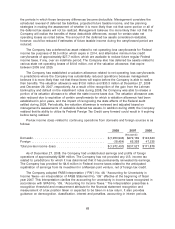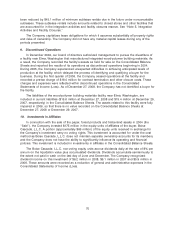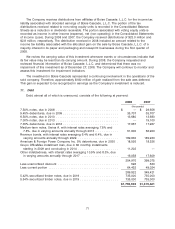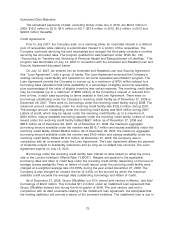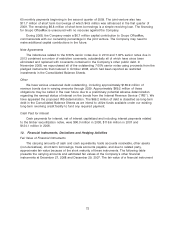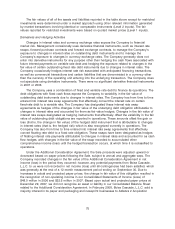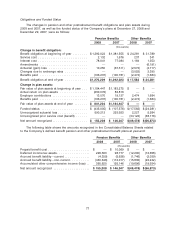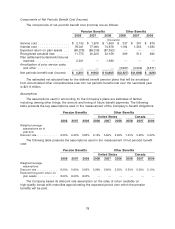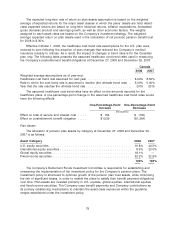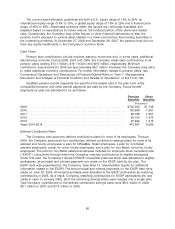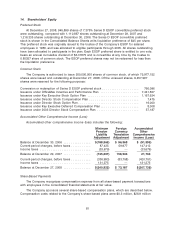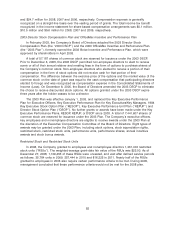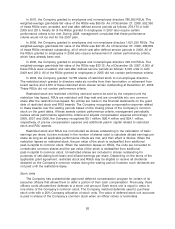OfficeMax 2008 Annual Report Download - page 79
Download and view the complete annual report
Please find page 79 of the 2008 OfficeMax annual report below. You can navigate through the pages in the report by either clicking on the pages listed below, or by using the keyword search tool below to find specific information within the annual report.The fair values of all of the assets and liabilities reported in the table above except for restricted
investments were determined under a market approach using other relevant information generated
by market transactions involving identical or comparable instruments (Level 2 inputs). The fair
values reported for restricted investments were based on quoted market prices (Level 1 inputs).
Derivatives and Hedging Activities
Changes in interest rates and currency exchange rates expose the Company to financial
market risk. Management occasionally uses derivative financial instruments, such as interest rate
swaps, forward purchase contracts and forward exchange contracts, to manage the Company’s
exposure to changes in interest rates on outstanding debt instruments and to manage the
Company’s exposure to changes in currency exchange rates. The Company generally does not
enter into derivative instruments for any purpose other than hedging the cash flows associated with
future interest payments on variable rate debt and hedging the exposure related to changes in the
fair value of certain outstanding fixed rate debt instruments due to changes in interest rates. The
Company occasionally hedges interest rate risk associated with anticipated financing transactions,
as well as commercial transactions and certain liabilities that are denominated in a currency other
than the currency of the operating unit entering into the underlying transaction. The Company does
not speculate using derivative instruments. There were no significant derivative financial instruments
in 2007 or 2008.
The Company uses a combination of fixed and variable rate debt to finance its operations. The
debt obligations with fixed cash flows expose the Company to variability in the fair value of
outstanding debt instruments due to changes in interest rates. The Company has from time to time
entered into interest rate swap agreements that effectively convert the interest rate on certain
fixed-rate debt to a variable rate. The Company has designated these interest rate swap
agreements as hedges of the changes in fair value of the underlying debt obligation attributable to
changes in interest rates and accounted for them as fair value hedges. Changes in the fair value of
interest rate swaps designated as hedging instruments that effectively offset the variability in the fair
value of outstanding debt obligations are reported in operations. These amounts offset the gain or
loss (that is, the change in fair value) of the hedged debt instrument that is attributable to changes
in interest rates (that is, the hedged risk) which is also recognized currently in operations. The
Company has also from time to time entered into interest rate swap agreements that effectively
convert floating rate debt to a fixed rate obligation. These swaps have been designated as hedges
of floating interest rate payments attributable to changes in interest rates and accounted for as cash
flow hedges, with changes in the fair value of the swap recorded to accumulated other
comprehensive income (loss) until the hedged transaction occurs, at which time it is reclassified to
operations.
Under the Additional Consideration Agreement, the Sale proceeds were adjusted upward or
downward based on paper prices following the Sale, subject to annual and aggregate caps. The
Company recorded changes in the fair value of the Additional Consideration Agreement in net
income (loss) in the period they occurred; however, any potential payments from Boise Cascade,
L.L.C. to us were not recorded in net income (loss) until all contingencies had been satisfied, which
was generally at the end of a 12-month measurement period ending on September 30. Due to
increases in actual and projected paper prices, the change in fair value of this obligation resulted in
the recognition of non-operating income in our Consolidated Statements of Income (Loss) of
$48.0 million in 2006 and $32.5 million in 2007. Based upon actual and projected paper prices at
December 29, 2007, we did not recognize an asset or liability in our Consolidated Balance Sheet
related to the Additional Consideration Agreement. In February 2008, Boise Cascade, L.L.C. sold a
majority interest in its paper and packaging and newsprint businesses to Aldabra 2 Acquisition
75


